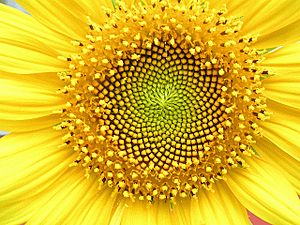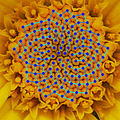Fibonacci number facts for kids
The Fibonacci numbers are a super cool pattern of numbers found in mathematics. They are named after an Italian mathematician called Leonardo of Pisa, who was also known as Fibonacci. In 1202, Fibonacci wrote a book called Liber Abaci (which means "Book of Calculation"). This book helped introduce these special numbers to people in Western Europe, even though mathematicians in India already knew about them.
Here's how the pattern works: The first number is 0, and the second number is 1. After that, you get the next number by adding the two numbers right before it. For example, 0 + 1 = 1, and 3 + 5 = 8. This amazing number pattern goes on forever!
How the Fibonacci Sequence Works
Let's look at the first few Fibonacci numbers. Remember, you just add the two numbers before to get the next one.
| F0 | F1 | F2 | F3 | F4 | F5 | F6 | F7 | F8 | F9 | F10 | F11 | F12 | F13 | F14 | F15 | F16 | F17 | F18 | F19 | F20 |
| 0 | 1 | 1 | 2 | 3 | 5 | 8 | 13 | 21 | 34 | 55 | 89 | 144 | 233 | 377 | 610 | 987 | 1597 | 2584 | 4181 | 6765 |
So, to find F2, you add F0 and F1 (0 + 1 = 1). To find F3, you add F1 and F2 (1 + 1 = 2). And so on! This rule is called a recurrence relation in mathematics.
Fibonacci Numbers in Nature

It's amazing how often Fibonacci numbers show up in nature! They are connected to something called the golden ratio. This special ratio appears in many places, from famous buildings to living things.
You can find Fibonacci patterns in many plants. For example, look at the pattern of leaves on a stem. Or check out the parts of a pineapple. The way an artichoke flowers also follows this pattern.
Even the uncurling of a fern or the arrangement of a pine cone can show Fibonacci numbers. These numbers also appear in the family tree of honeybees. It's like nature uses these numbers as a secret code for growth!
Images for kids
See also
 In Spanish: Sucesión de Fibonacci para niños
In Spanish: Sucesión de Fibonacci para niños



